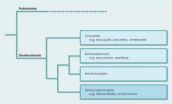Modern-day Africa south of the Sahara is home to a unique variety of mammals, a great number of which are not found anywhere else in the world. Biogeographers have long recognized that sub-Saharan Africa constitutes one of the world's six major mammalian biogeographic divisions, termed 'realms'. However, the historical development of these continental regions of biogeographic diversity has been little explored.
Description of six million-year-old fossil antelopes from the Middle Awash in Ethiopia's Afar Region has now provided new information on the development of today's sub-Saharan mammalian community. The new fossils are identified as a spiral-horned antelope named Prostrepsiceros cf. vinayaki. These Ethiopian fossils are closely related to species previously described from the Indian Subcontinent and Arabia and constitute the first African record of this otherwise Eurasian antelope. The discovery of a Eurasian antelope in Africa nearly six million years ago (Mya) is of significance given the extraordinary isolation of sub-Saharan antelope communities today. The new fossils therefore signal a period of time when mammalian dispersal between Africa and Eurasia remained less restricted than today.
More information on the historical development of modern African biogeography is gleaned from a review of the African record of fossil bovids (the natural group comprising antelopes, oxen, and kin). By seven Mya and up to five Mya, the composition of African bovids is already clearly distinguished from that of Europe and Asia; however, barriers to mammalian dispersal among these three continental regions are much weaker than in the modern world. This is evidenced by the retained presence of very similar species, such as the Middle Awash fossil antelope and multiple species of tragoportacin antelopes, a now extinct group that at this time ranged widely across Eurasia and Africa.
In contrast, the record of fossil bovids after five Mya indicates extremely limited faunal exchange taking place between Africa and Eurasia. Despite the presence of very large fossil assemblages from the last five million years, there are few records of closely related bovid species shared between African and Eurasian sites throughout this time. The study proposes that a major biogeographic break occurred around five million years ago, after which time the proportion of Eurasian taxa in Africa decreased significantly, beginning to resemble the situation in sub-Saharan Africa today. African fossil sites from between six and five million years ago, such as those from the Middle Awash from which the hominid Ardipithecus kadabba has been named, are then recognized to lie just before this notable increase in African biogeographic isolation.
The Ethiopian biogeographic realm therefore appears to have had a distinct history of ever-increasing isolation over the last seven million years. The modern African sub-Saharan mammalian community may be understood to be the vestiges of a once wider-ranging and more broadly connected African mammalian fauna. The causes of the gradual geographic restriction of Africa's mammals over time are not clear, but global climate change may be implicated. With gradual cooling and drying taking place globally since 17 Mya, strengthened latitudinal climatic gradients might have created ecological barriers to dispersal between the African continent to the south and the Eurasian landmass to the north. With the onset of the northern hemisphere glaciation and ice age cycles of the last 2.5 million years, intensified subtropical aridity and the expansion of the Saharan and Arabian deserts probably played a major role in the modern-day isolation of sub-Saharan mammalian communities.
The last seven million years is the time during which hominids, the human line from our last common ancestor with chimpanzees, evolved and dispersed from Africa. The earliest hominids are known from about seven to five Mya and include Ardipithecus kadabba from the Middle Awash, Orrorin tugenensis from Kenya, and Sahelanthropus tchadensis from Chad. Bovids have a very large and rich fossil record and are usually among the most abundant fossil taxa found at hominid sites. Studies on the bovid record therefore provide one of the best proxies for reconstructing large-scale paleobiological patterns as well as direct evidence for the contexts of early human evolution. Through description of the new Middle Awash specimens and a review of the bovid fossil record, this paper also sheds light on the continental-scale biogeographical context of early human evolution.
###
Citation: Bibi F (2011) Mio-Pliocene Faunal Exchanges and African Biogeography: The Record of Fossil Bovids. PLoS ONE 6(2): e16688. doi:10.1371/journal.pone.0016688
Funding: This study was supported by a National Science Foundation Graduate Research Fellowship, a National Science Foundation International Research Fellowship Award (#0852975), the Institute International de Pale´oprimatologie et Pale´ontologie Humaine (I.P.H.E.P.), the Agence Nationale de la Recherche (ANR-09-BLAN-0238), the Revealing Hominid Origins Initiative (R.H.O.I.), a Geological Society of America Ross Research Award, a Yale University Enders Grant, a Yale Institute for Biospheric Studies Center for Field Ecology grant, a Yale ECOSAVE Center grant, the Abu Dhabi Authority for Culture and Heritage, and the Rimo Ramses Nakhle Foundation. The funders had no role in study design, data collection and analysis, decision to publish, or preparation of the manuscript.
Competing Interests: The author has declared that no competing interests exist.
PLEASE LINK TO THE SCIENTIFIC ARTICLE IN ONLINE VERSIONS OF YOUR REPORT (URL goes live after the embargo ends): http://dx.plos.org/10.1371/journal.pone.0016688
Disclaimer:
This press release refers to upcoming articles in PLoS ONE. The releases have been provided by the article authors and/or journal staff. Any opinions expressed in these are the personal views of the contributors, and do not necessarily represent the views or policies of PLoS. PLoS expressly disclaims any and all warranties and liability in connection with the information found in the release and article and your use of such information.
About PLoS ONE
PLoS ONE is the first journal of primary research from all areas of science to employ a combination of peer review and post-publication rating and commenting, to maximize the impact of every report it publishes. PLoS ONE is published by the Public Library of Science (PLoS), the open-access publisher whose goal is to make the world's scientific and medical literature a public resource.
END



